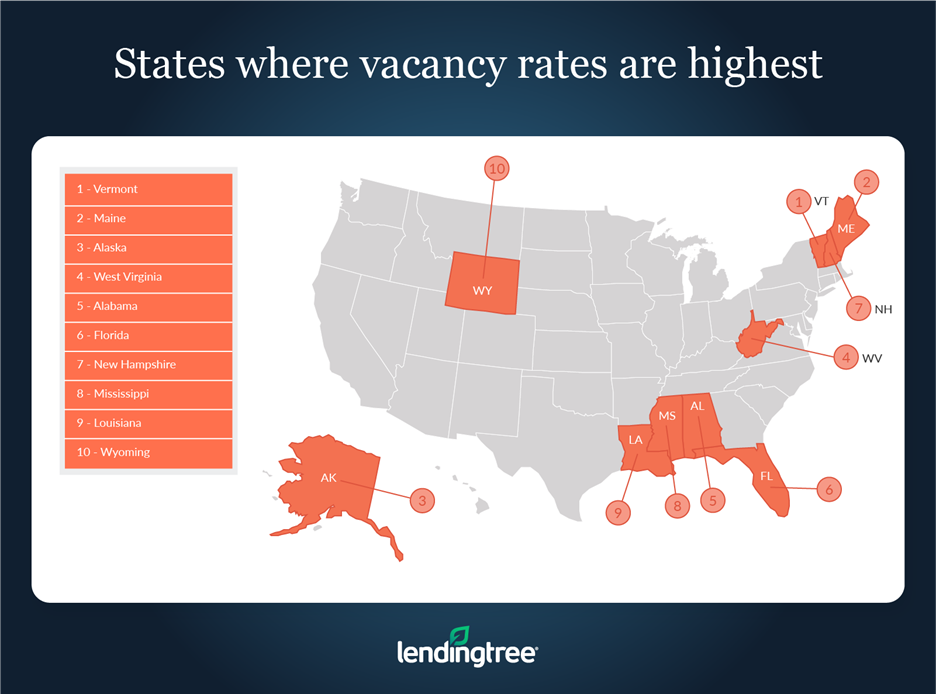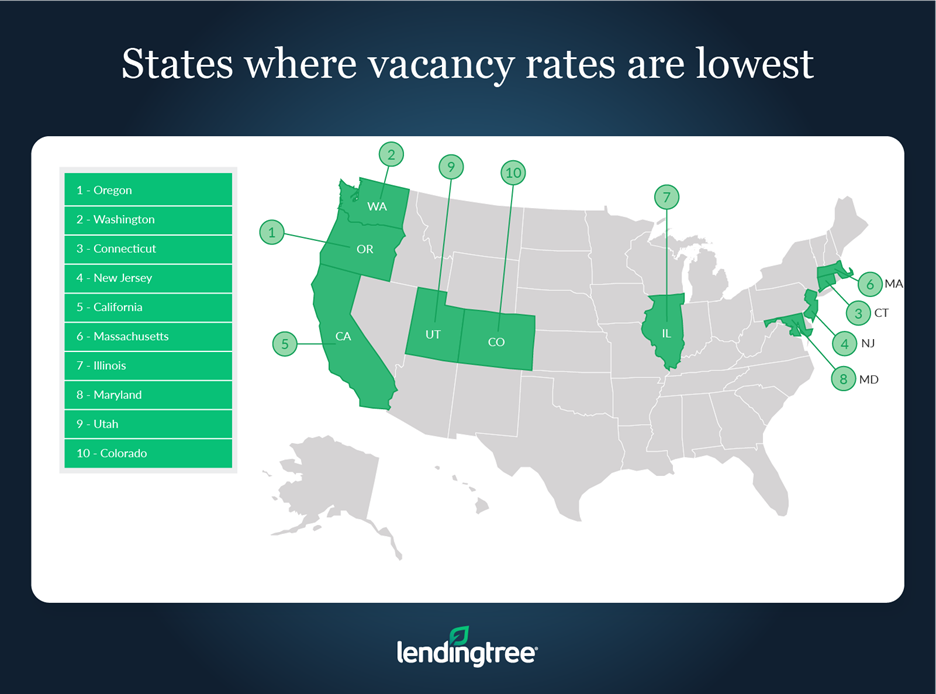16 Million Homes Are Vacant in the U.S. — Here Are the States With the Highest Vacancy Rates
Even in the face of rising mortgage rates and stagnating construction numbers, the housing market is still scorching hot. Because of this, it may be difficult to believe that more than 16 million homes across the U.S. are sitting vacant.
But this doesn’t mean millions of abandoned and dilapidated homes are withering away in the suburbs. Vacant homes can be unoccupied for many reasons beyond being uninhabitable. For example, a house can be vacant because it’s still on the market to be sold or rented or it’s a vacation home not currently in use.
Regardless of why homes are vacant, knowing an area’s vacancy rate can be an important part of understanding the overall health of its housing market.
To get a sense of vacancy rates in the U.S., LendingTree analyzed the latest U.S. Census Bureau data to rank the nation’s 50 states by their shares of unoccupied homes. Though areas with higher vacancy rates are often less expensive, that isn’t always the case. In fact, there are some notable instances where a state’s median home price and its vacancy rate can both be relatively steep.
Key findings
- Vermont, Maine and Alaska are the states with the highest vacancy rates. Vacancy rates in these states are 22.86%, 22.68% and 20.51%, respectively. In total, that translates to more than 315,000 unoccupied houses across the three states.
- Oregon, Washington and Connecticut are the states with the lowest vacancy rates. Oregon has the lowest vacancy rate at 7.76%, followed by Washington at 7.87% and Connecticut at 8.09%. While these states have the lowest vacancy rates, that doesn’t mean they have the fewest vacant homes. With almost 521,000 unoccupied housing units across the three states, there are nearly 206,000 more vacant homes across Oregon, Washington and Connecticut than in Vermont, Maine and Alaska.
- Home prices in states with higher vacancy rates are often — but not always — lower than in states with lower vacancy rates. Median home prices across the 10 states with the highest vacancy rates are an average of about $168,000 lower than in the 10 states with the lowest vacancy rates. But there are exceptions. For example, Alaska boasts a higher-than-average median home value despite having one of the nation’s highest vacancy rates.
States with the highest vacancy rates
No. 1: Vermont
- Total housing units: 341,405
- Vacant housing units: 78,052
- Vacancy rate: 22.86%
- Median home value: $235,000
No. 2: Maine
- Total housing units: 755,380
- Vacant housing units: 171,323
- Vacancy rate: 22.68%
- Median home value: $211,000
No. 3: Alaska
- Total housing units: 321,385
- Vacant housing units: 65,929
- Vacancy rate: 20.51%
- Median home value: $288,100

States with the lowest vacancy rates
No. 1: Oregon
- Total housing units: 1,830,846
- Vacant housing units: 141,983
- Vacancy rate: 7.76%
- Median home value: $373,500
No. 2: Washington
- Total housing units: 3,242,721
- Vacant housing units: 255,063
- Vacancy rate: 7.87%
- Median home value: $419,500
No. 3: Connecticut
- Total housing units: 1,530,056
- Vacant housing units: 123,819
- Vacancy rate: 8.09%
- Median home value: $287,500

If so many homes are vacant, why are housing prices still so high?
In theory, vacancy rates should have a strong inverse relationship to home prices. In other words, a high vacancy rate would signify a lack of demand from buyers, which in turn would result in a larger supply of homes on the market and lower prices. The inverse would also be true where a low vacancy rate would signify a strong demand from buyers, less supply on the market and higher prices.
Because of this, it may be tempting to blame the current hot housing market solely on an overabundance of vacant homes on the market.
However, as is often the case when economic theory unfolds in real life, this theoretical framework doesn’t always hold. For example, the median home price in New Hampshire— the state with the seventh-highest vacancy rate — is about $10,000 higher than the median home price in Connecticut, where vacancy rates are the third-lowest in the nation.
This means there are many other factors in play that help dictate home price, like location, the kind of rates being offered to borrowers, square footage and the reasons why homes are sitting unoccupied — to name a few.
Because of this, vacancy rates alone can’t fully explain why homes are so expensive. But that doesn’t mean that vacancy rates are unimportant. Understanding an area’s vacancy rate can help shed light on how buyers and homeowners behave.
For example, if both vacancy rates and home prices are relatively low, it could mean that sellers are parting with their homes for less money than they could have potentially gotten. If vacancy rates are low and housing prices are high, it could signify that the market is highly competitive and that lower-income people might have a problem finding a house.
On the flip side, high vacancy rates and high home prices can suggest that an area has unique characteristics, such as being a vacation hot spot or targeted by investors. Meanwhile, high vacancy rates and low home prices might mean an area is experiencing socioeconomic hardships.
Tips for dealing with low inventory and a hot housing market
With high prices, rates rising and a limited number of homes available for sale, it can be tricky for buyers to navigate today’s housing market. But by keeping the following tips in mind, homebuyers may find dealing with the market less daunting than they initially expected.
- Shop around for the best possible rate. By shopping around and making different lenders compete for your business before you get a mortgage, you may be able to secure a lower interest rate than you would have had you gone with the first lender. The lower your rate, the less money you’ll need to spend on housing costs each month and the more expensive a home you’ll be able to afford.
- Consider different loan options. Not all lenders have the same mortgage requirements. If you’re worried that you won’t qualify for a traditional 30-year, fixed-rate mortgage, you may still find that you can get approved for loans from places like the Federal Housing Administration (FHA) or the Department of Veterans Affairs (VA).
- Don’t rush. With mortgage rates rising, you may feel pressure to rush into buying a house so that you can avoid paying higher interest. However, if you’re not in a position where you can comfortably afford a home or where you’re unsure if you want to be a homeowner, it may not be the best idea to buy right away. Being stuck in a home that you can’t afford or don’t want to live in can be worse than taking your time and potentially ending up with a slightly higher interest rate.
Methodology
All the data used to conduct this study comes from the U.S. Census Bureau’s 2020 American Community Survey with one-year experimental estimates.
The survey measures the overall vacancy rate in a state by dividing the number of vacant households by the total number of households. Occupied households include homes owned or rented by occupants who use the home as their primary residence, while vacant households are broken down into seven subcategories. The U.S. Census Bureau defines these subcategories as follows:
- For rent: These are vacant units offered “for rent,” or vacant units that are offered for either sale or rent.
- Rented, not occupied: These are vacant units where a rental agreement has been reached but the future occupants haven’t moved in yet.
- For sale only: These are vacant units currently on the market.
- Sold, not occupied: Similar to “rented, not occupied,” this category covers homes that have sold but the new owner hasn’t moved in yet.
- For seasonal, recreational or occasional use: These include homes for seasonal use like beach cottages and hunting cabins or lodging for seasonal workers like herders and loggers. Timeshare condominiums are also included here.
- For migrant workers: These are homes for migrant workers to occupy while they’re employed in farm work during the crop season.
- Other vacant: This category captures vacant homes that don’t fall into any of the above.
Correction: Because of a data error, median home values were incorrect in the initial version of this study. They were fixed on March 10, 2022.
